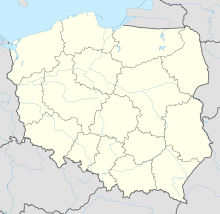Danzig head
Coordinates: 54 ° 16 ′ 15.2 ″ N , 18 ° 57 ′ 14.7 ″ E
As Danzig Haupt ( Polish Głowa Gdańska ) a farm or a headland and in the 17th century a fortress in the Vistula Delta was called. The place is named after the city of Danzig , on whose territory it was located.
geography

At this point of land, the main current of the Vistula divided into the Danzig Vistula, which led to Danzig, and the Elbinger Vistula, which flows into the Fresh Lagoon . When the Vistula Pier (Przekop Wisły) was created in the Baltic Sea in the years 1889 to 1895 , the Elbinger Arm (today Szkarpawa ) was separated from the newly created river switch by a lock system. This flows today on the west side of the Gdańsk Main directly into the Gdańsk Bay , while the Kühne and Tote Weichsel towards Gdańsk were also separated by a lock.
history

The head of Danzig was a strategically important place for the city and its trade. During the Polish-Swedish War (1600–1629) a fortress with four bastions was built here . In July 1626 this was captured by Swedish troops. King Gustav II Adolf had the fortifications considerably expanded and reinforced. The strong occupation controlled the Vistula trade in Poland-Lithuania until 1635. In the Treaty of Altmark of September 25, 1629, Elector Georg Wilhelm, Duke in Prussia , received, among other things, the Danzig head and the Marienburger Werder in sequestration from his Swedish brother-in-law .
In the Treaty of Stuhmsdorf of September 12, 1635, Danzig came back into possession of the fortress and had it occupied by its own troops. With the beginning of the Second Northern War (1655-1660) the garrison was reinforced to 200 men. After the Konigsberg Treaty in 1656, the Danzig head was again occupied by the Swedish. Until 1657, the head was expanded again under Karl X. Gustav and expanded in the Dutch manner . Two ship bridges made it possible to cross the two arms of the Vistula under the protection of the fortress. A crew of 600 to 800 men was under the command of Colonel Niclas Danckwardt-Lillieström (1613–1681). His half-brother Johann Ahus (en) took part in 1635 as a Swedish commissioner in the negotiations that were concluded in Stuhmsdorf.
The fortress controlled the entire Vistula lowland and could not be captured several times. From September 25, 1659 on, the Danzig commander Valentin von Winter besieged the fortress with 5500 men. The Swedes capitulated and received their honorable exit on December 22nd.
Originally the fortress was supposed to be preserved and expanded. However, since the maintenance of the facilities exceeded the means of the city of Danzig and the facilities were repeatedly used by enemy troops, it was decided to demolish it at the end of the 17th century.
During the time of the Republic of Danzig , French troops established themselves here again. Part of the Danzig head was washed away when the Vistula pierce was made.
Living space
A residential area of the rural community Schönbaumerweide (today Drewniczka), which in 1905 had 75 inhabitants, was also referred to as Danziger Haupt or just Haupt .
traffic
The lock chamber, built in 1895, is 103 meters long and 12.5 meters wide. It serves the shipping traffic and boat tourism between Gdansk and the Fresh Lagoon. A bridge has been crossing the waterway since 1973.
See also
- Montauerspitze (also Nogat Haupt ), headland and Swedish fortifications (1626–1659).
literature
- Edmund Cieślak: Historia Gdańska: Okres “potopu” szwedzkiego . Volume 3: 1655-1793 . Instytut Historii PAN, Gdańsk 1993, ISBN 83-215-3251-9 , p. 42 ff.
- Gdansk at all . In: Bernhard Meijer, Theodor Westrin (ed.): Nordisk familjebok konversationslexikon och realencyklopedi . 2nd Edition. tape 5 : Cestius-Degas . Nordisk familjeboks förlag, Stockholm 1906, Sp. 1385-1386 (Swedish, runeberg.org ).
Web links
- Piotr Paluchowski: Gdańska Głowa . Gedanopedia (Polish)
- Stilleståndet i Altmark 1629 . Svenskt Militärhistoriskt Bibliotek (Swedish)

